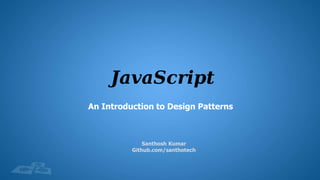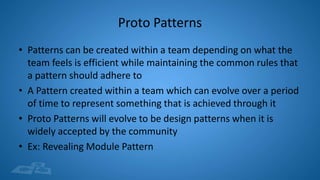Introduction to Design Patterns in Javascript
- 1. Santhosh Kumar Github.com/santhotech An Introduction to Design Patterns
- 2. What are Design Patterns • Design Patterns provide the roadmap to implement solutions for various issues in software development • A ready made solution that can be customized and reused • A design pattern will make the code look self expressive by providing structure and semantics to the code • They are not the final solution but a means to achieve the solution in an elegant manner • Provides a common platform and reduces time required for transition
- 3. Advantages • Provides the ability to reuse code that can save a lot of time • It is a standard that developers are aware of hence improves the understanding of code base new/old within a team • If used efficiently can help in reducing the overall footprint • Provides multiple platforms that doesn’t constraint the usage or dictate the behaviour while maintaining the sanity of the system • Helps in faster testing and implementation
- 4. Design Pattern Categories • Creational Design Patterns – Deals with the way a class and object instances are created • Structural Design Patterns – Deals with maintaining structural integrity of the system by enforcing sane relationships • Behavioural Design Patterns – Helps in establishing communication between distinct parts of the system (or) Object communication
- 5. Creational Patterns • Deals with Object creation mechanism and class creation mechanism • Provides a way for object creation depending on the changing scenarios • Reduces duplication in terms of instantiation • Reduces memory over head in dealing with multiple objects of the same type • Ex: Constructor, Factory, Abstract, Prototype, Singleton, Builder etc
- 6. Structural Design Pattern • Provides a set of protocols on structuring the components of the system • Helps in reducing/decoupling the structural dependencies with in a system • Provides a means to create independent structures that can maintain their own state • Helps in restructuring the components of the system which doesn’t have a common purpose • Ex: Decorator, Façade, Adapter, Proxy etc
- 7. Behavioural Design Pattern • Focuses on streamlining the communication between the objects in the system • Helps in establishing a common set of protocols to pass data and keep objects in sync • Provides a means to ensure reactive implementation of objects irrespective of their state • Ensures that communication happens through as less channels as possible to ensure maintainability • Ex: Iterator, Mediator, Chain of Command, Observer, Visitor etc
- 8. Design Patterns in OO Javascript • JavaScript is a Pseudo class based language – Functions are manipulated to simulate a class based environment • All JS objects are inherited from “Object” using a base constructor • All constructors gets a prototype object • All default properties of an object is assigned in the prototype • Each individual object consists of its own prototype which inherits from the parent
- 9. Constructor pattern • Creational Design Pattern • Javascript objects can be created by • var obj = {}; • var obj = Object.create(Object.prototype); • Var obj = new Object(); • Any call to a function is actually a call to a constructor method of the same function since functions behaves like classes in javascripts • Adding a “new” to a constructor makes it return a empty instance (if passed without parameters) of the object the constructor points to
- 10. Cont… function Animal(name, class) { this.name = name; this.class = class; this.getName = function() { return “Name :”+this.name; } Var a1 = new Animal(“lion”, “predator”); Var a2 = new Animal(“Tiger”, “predator”);
- 11. Cont… • All common methods can be grouped in a single wrapper • “this” refers to the current object inside the constructor function • Not ideal as inheritance cannot be implemented directly – scope of “this” referring to the methods will result in a conflict • Methods referenced with this gets redefined for every instance that is created – end up with 100 “getName” definitions if there are 100 animals
- 12. • JS consists of a prototype property that is available for all functions • Any number of methods and properties can be attached to the prototype property of the function • When constructor is called to create new object the properties attached to prototype of the constructor is automatically available to the new object • The “this” keyword inside a property attached to prototype will still refer to the current object
- 13. function Animal(name, class) { this.name = name; this.class = class; } Animal.prototype.getName = function() { return “Name :”+this.name; } Var a1 = new Animal(“lion”, “predator”); Var a2 = new Animal(“Tiger”, “predator”);
- 14. Usage/Merits/Demerits • Ideal for wrapping up related and group able properties within an object container • Can be used where ever a fundamental level of abstraction is required • Provides a very easy implementation of inheritance and prototypal inheritance • Doesn’t provide a direct mechanism to contain private members
- 15. Object Literal Pattern • Another Creational Design Pattern • Not the usual means to “instantiate” an object • Provides a way to group related behaviour usually in terms of a page/UI component
- 16. Var gridComponent = { settings: { gridColor: “#ff0000”, gridTitle: “My Title” }, init: function{ if (settings && settings(settings) == 'object') { $.extend(gridComponent.settings, settings); } gridComponent.bindEvents(); } bindEvents: function() { $(“#btn”).on(“click”, function() { gridComponent.onButtonClick(); }); $(“#drp”).on(“change”, function() { gridComponent.onDrpChange(); }); } }
- 17. Usage/Merits/Demerits • Can be used especially when dealing with third party libraries like Jquery to group common behaviour • Instead of spaghetti calling methods of same component just a online initiation replaces all other calls • Code may be longer than other forms of implementation • But the grouping helps in maintainability • Doesn’t provide private members
- 18. Modular Pattern • Provides the ability to effect namespacing • Allows creation of private members • Expose only certain logic that needs to be used by other parts of the system • Helps to keep the global namespace clean and free of pollution from the method variables
- 19. Var Chart = (function(){ var chartWidth = 100; var chartHeight = 100; getAxis = function(param) { return Math.round(rand(param,2)); } return { generateChart: function(chartParam) { return getAxis(chartParam); } } })();
- 20. Usage/Merits/Demerits • Can be used where private members are required to keep the namespace clean and avoid naming conflicts which is also the advantage of using this pattern • The private methods cannot be extended since their visibility is shielded • Objects added later to the chain does not have access to the private members • Private members cannot be unit tested
- 21. Revealing Module Pattern • A Slight variation of the modular pattern • In module pattern public methods need to address one another along with the name of module • Revealing module pattern addresses this by returning an object with references to the methods that are public and keeping all methods private by default
- 22. var Chart = (function(){ var chartX = 0; var chartY = 0; function manipulate() { } function manipulateXY() { return manipulate(); } function generateChart(param) { return manipulateXY(); } return { getChart: generateChart }; })(); Chart.getChart(param);
- 23. Usage/Merits/Demerits • Syntax is much cleaner as the return object clearly specifies what are returned hence establishing what are public • Pattern is flexible enough only for public methods and not for public members • Does not play well with inheritance as the public methods returned cannot be overridden since only reference is returned
- 24. Singleton Pattern • Restricts the instantiation of a class to just once such that it returns the same instance whenever and wherever it is requested from • Singletons in JS returns a structure rather than returning an object or more precisely a reference to an object
- 25. Var Helper = (function(){ var helperInstance; function init() { function domHelperPvt() { } var domHelperPvtProp = 0; return { domHelperPub: function () { }, domHelperPubProp: 1 }; }; return { getHelperInstance: function () { if ( !helperInstance) { helperInstance = init(); } return helperInstance; } }; })(); Var helper = Helper.getHelperInstance(); Helper.domHelperPub();
- 26. Usage/Merits/Demerits • Used to create static instance like behaviour for accessing methods that are common across a wide range of components in a system • Reduces memory overhead and helps in sane garbage collection • Too many singletons will result in application being tightly coupled, hence reduce the performance and also maintainability
- 27. Factory Pattern • Provides a platform to provide objects that may be required frequently from time to time and also used by multiple components • Not restricted to one instance but may not necessarily create new instance if the existing one can be reused • Also a creational pattern
- 28. Function DomFactory { this.createNewDom = function(domtype,param) { var newDom; if(domType===“chart”) { newDom = new Chart(param); } if(domType===“grid”) { newDom = new Grid(param); } return newDom; } } DomFactory.createNewDom(“chart”,param);
- 29. Usage/Merits/Demerits • Useful when the calling client may need different objects depending on the scenario and such clients exist across the system • Reduces the logical overhead in the client requesting for the object and moves common logic to a common wrapper that can be reused as necessary • Cannot be used when there is no common behaviour between the objects returned
- 30. Proto Patterns • Patterns can be created within a team depending on what the team feels is efficient while maintaining the common rules that a pattern should adhere to • A Pattern created within a team which can evolve over a period of time to represent something that is achieved through it • Proto Patterns will evolve to be design patterns when it is widely accepted by the community • Ex: Revealing Module Pattern
- 31. Thank You































